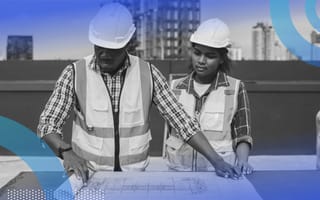There is a seismic shift happening in the construction industry. Approaches to the design, management and execution of projects are radically changing.
The driving forces behind this transformation? Machine learning and computer vision.
A construction site foreman used to spend hours each day inspecting for safety violations. Now, AI-powered cameras do the work, preventing accidents before they happen. As organizations pivot rapidly to accommodate new tools and capabilities, they must also approach these solutions with a clear-eyed understanding of their true potential.
Machine learning and computer vision are not standalone solutions; rather, they work in tandem with other capabilities, such as the Internet of Things, generative AI and 5G networks. By integrating these technologies, construction companies can remove barriers to execution and unlock even greater value than they could by implementing them individually.
How Does Machine Learning Work in Construction?
Machine learning, at its core, is about teaching computers to learn from data and make predictions. I’ve seen firsthand how machine learning algorithms can analyze historical project data, identifying patterns and insights that would be impossible for humans to determine. This translates to a wealth of possibilities in construction.
Benefits of Machine Learning in Construction
- Optimizing resource allocation: By predicting material needs and equipment usage, we can minimize waste and reduce costs.
- Enhancing project scheduling: Machine learning models can identify potential bottlenecks and suggest adjustments to keep projects on schedule.
- Improving risk management: By analyzing past projects, we can identify common risks and develop mitigation strategies.
With machine learning, schedulers can accomplish in just hours what used to take days. This improved efficiency enables them to focus on other high-level tasks.
The key to unlocking the true potential of machine learning, however, lies in data. The more high-quality data we provide these algorithms, the more accurate and insightful their predictions become.
Let’s say you’re trying to predict potential delays on one of your projects. Historical project data will be important to assess, along with real-time sensor data, which feeds back information like equipment utilization and downtime, material deliveries and inventory as well as worker location and movement.
The more detailed, accurate and relevant data we can feed the machine learning algorithms, the better they’ll become at predicting things like potential delays, cost overruns and even safety hazards.
How Does Computer Vision Work in Construction?
Computer vision, as the name suggests, empowers computers to “see” and interpret visual information. This translates to a powerful tool for activities such as the following.
Benefits of Computer Vision in Construction
- Automated progress monitoring: Drones equipped with computer vision can capture high-resolution images and videos of job sites, generating 3D models and providing real-time progress updates. This eliminates the need for manual inspections and reduces the risk of errors.
- Enhanced safety protocols: Computer vision systems can monitor worker behavior, ensuring compliance with safety regulations and identifying potential hazards. For example, it can identify workers who are not wearing proper protective equipment or detect unsafe conditions on site. This real-time monitoring allows for immediate intervention, potentially preventing accidents and saving lives.
- Improved quality control: By analyzing images of completed work, computer vision algorithms can identify defects or deviations from design specifications, ensuring that projects meet the highest quality standards.
The convergence of computer vision with other technologies like IoT, generative AI and 5G networks amplifies its impact.
Imagine a network of sensors embedded throughout a construction site, collecting real-time data on everything from temperature and humidity to equipment performance and material movement. This data provides a comprehensive and dynamic view of the project, enabling us to make better informed decisions at every stage.
These technologies work better in unison than as standalone solutions. IoT and 5G serve as data gathering systems, while computer vision and generative AI act as the brains of the operation, analyzing the data and providing real-time insights.
IoT sensors, embedded in equipment, materials and throughout a construction site, collect data on temperature, vibrations, materials levels and more.
5G transmits this massive amount of data from sensors in real-time with speed and bandwidth.
Then, computer vision monitors the site by analyzing the data from sensors to actually understand what they’re seeing. For example, is a crane operating within safety parameters? Is a worker missing their hard hat?
Generative AI takes a closer look at the historical data and real-time conditions to identify potential problems before they impact the project. This can predict a concrete pour will be delayed due to weather, for example, allowing project managers to adjust schedules proactively.
What Makes This Tech Thrive? Centralized Data.
To fully harness the power of these technologies, businesses must have their data and task management strategies in order. Choosing the right digital platform to handle data in a common data environment is crucial for effectively mining intelligence.
By centralizing data and making it easily accessible, you gain valuable insights that can inform decision-making and drive continuous improvement across projects.
Imagine one team has spreadsheets tracking material deliveries, the second uses a separate software for equipment maintenance logs and the project manager relies on emails and calls for updates. This is the siloed data nightmare, where information is fragmented, making it nearly impossible to get a clear, holistic view together.
With everyone working from the same, up-to-date information, they can foster better communication and faster decision-making, instead of each team being on a remote data island. Sharing data allows you to analyze trends and patterns across multiple teams to identify risks and opportunities for improvement.
We’re building the future of construction on a foundation of data, innovation and collaboration. By embracing machine learning, computer vision and other emerging technologies, we can achieve unprecedented levels of efficiency and safety.





